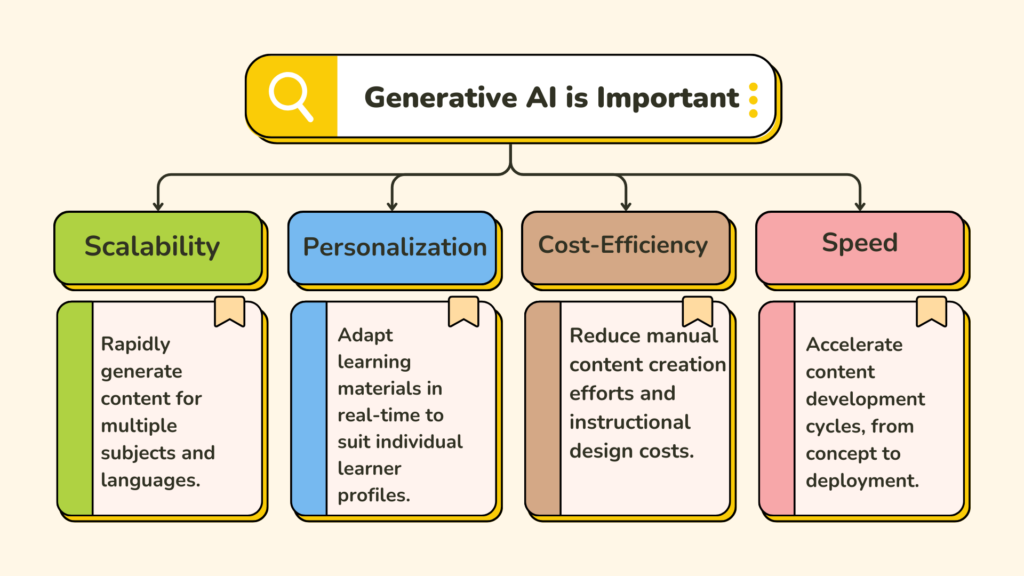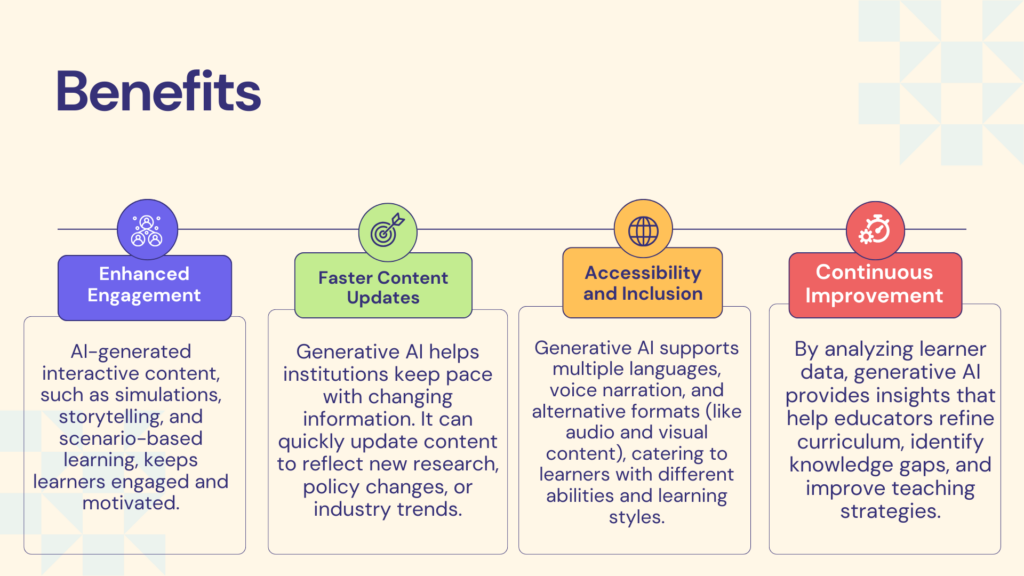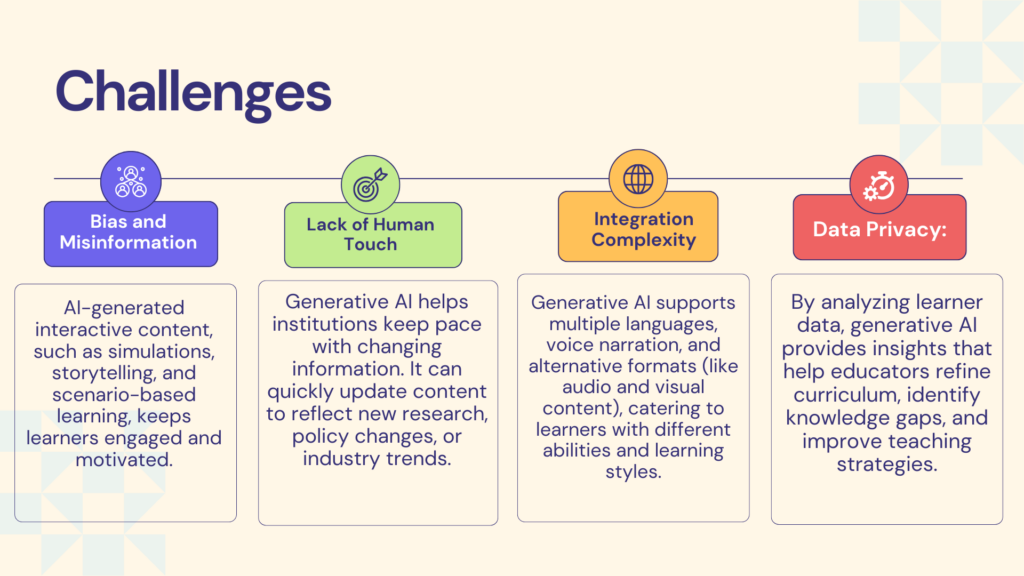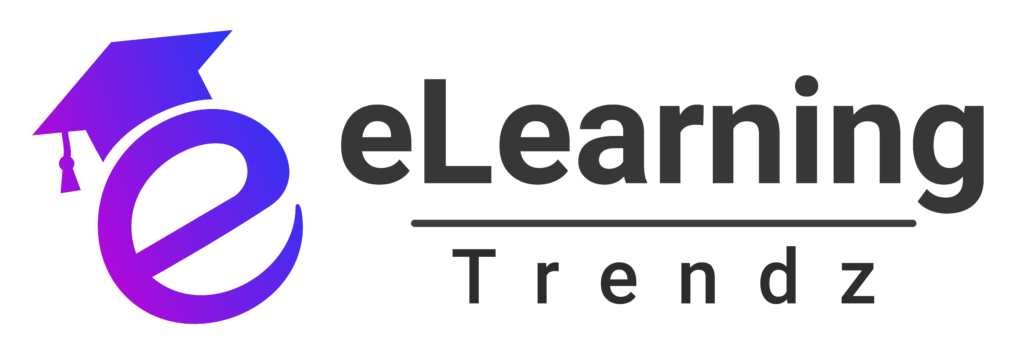Table of Contents
In the rapidly evolving digital learning landscape, generative AI in eLearning is revolutionizing how educational content is created, personalized, and delivered. Traditional eLearning methods, while effective, often struggle to meet the individual needs of diverse learners. Enter generative AI—a transformative force that is reshaping education by enabling smart, adaptive, and engaging learning experiences tailored to each learner’s needs.
This blog explores how generative AI in eLearning is driving the next wave of innovation, offering benefits for learners, educators, and organizations alike. From dynamic content creation to intelligent assessments and real-time feedback, generative AI is setting a new benchmark for digital learning solutions.
What is Generative AI in eLearning?
Generative AI in eLearning refers to the application of artificial intelligence models, such as GPT (Generative Pre-trained Transformer), to automatically create, adapt, and optimize educational content and experiences. Unlike rule-based systems, generative AI uses large datasets and deep learning to understand context, predict outcomes, and generate human-like content.
This includes:
- Creating personalized lesson plans
- Developing interactive simulations
- Generating quizzes and feedback
- Crafting tailored learning paths
Why Generative AI is Important in Modern eLearning

Key Applications of Generative AI in eLearning
1. Personalized Learning Experiences
Generative AI customizes the learning journey by analyzing student behavior, performance data, and preferences. It dynamically adjusts:
- Learning paths
- Difficulty levels
- Content formats
This personalized approach helps improve learner engagement and outcomes.
2. Automated Content Creation
3. Real-Time Feedback and Assessment
4. Intelligent Virtual Tutors
AI-powered chatbots and virtual assistants are becoming integral in eLearning systems. They provide 24/7 support, answer questions, and guide learners through course materials, mimicking human interaction while scaling efficiently.
5. Language Translation and Localization
Generative AI tools can translate and localize eLearning content, making it accessible to global audiences. This not only breaks language barriers but also tailors cultural nuances for better understanding.
Benefits of Generative AI in eLearning

Challenges of Using Generative AI in eLearning

How to Implement Generative AI in Your eLearning Strategy
1. Choose the Right AI Tools
2. Start with Pilot Projects
Begin with small-scale projects such as automating quiz creation or developing a personalized course module. This helps validate the effectiveness before scaling.
3. Monitor and Evaluate
Continuously monitor the AI-generated content for quality, relevance, and accuracy. Use analytics to assess learner engagement and course effectiveness.
4. Blend AI with Human Oversight
AI should augment—not replace—educators. Combine AI efficiency with human insight to create emotionally intelligent and pedagogically sound courses.
Real-World Examples of Generative AI in eLearning
Example 1: Adaptive Corporate Training
Example 2: Higher Education Enhancement
Universities use generative AI to generate supplemental reading materials, explain complex topics using analogies, and create mock exams—all customized to individual learning needs.
Example 3: K-12 Education
In school settings, generative AI helps create engaging educational games, story-based lessons, and practice tests that adapt to each student’s progress, enhancing early learning outcomes.
Future of Generative AI in eLearning
As AI models become more advanced, the future of generative AI in eLearning will see even more integration of virtual reality (VR), augmented reality (AR), and emotion AI.
- AI-Driven Storytelling: Dynamic narratives tailored to learning objectives
- AI-Powered Simulations: Virtual labs and real-world scenarios for experiential learning
- Voice-Based Learning: Natural language interactions with virtual instructors
These advancements will lead to more immersive, inclusive, and outcome-oriented education systems.
Best Practices for Using Generative AI in eLearning
- Ensure content accuracy with human validation
- Protect user data with strong encryption and compliance
- Regularly update AI training datasets
- Foster ethical AI use and avoid biases
- Incorporate diverse learning modalities—text, audio, video
By following these best practices, institutions and businesses can harness the full potential of generative AI in eLearning without compromising quality or ethics.
Conclusion
Generative AI in eLearning is not just a trend—it’s a game-changing force that’s redefining how knowledge is created, shared, and consumed. From personalized learning paths and intelligent tutoring to rapid content creation and immersive simulations, the applications are vast and growing.
FAQs: Generative AI in eLearning
Generative AI in eLearning refers to the use of AI models to automatically create, personalize, and optimize digital learning content and experiences.
It enhances eLearning by personalizing content, automating creation, offering real-time feedback, and enabling adaptive learning paths for better engagement and outcomes.
Yes, but human oversight is essential. AI can generate content quickly, but accuracy, relevance, and bias must be reviewed by educators or instructional designers.
No, generative AI is a support tool. It complements educators by automating repetitive tasks and enhancing content, but it cannot replace human empathy and pedagogical expertise.
Risks include misinformation, data privacy issues, content bias, and lack of emotional connection. These can be mitigated with proper oversight and ethical AI practices.














